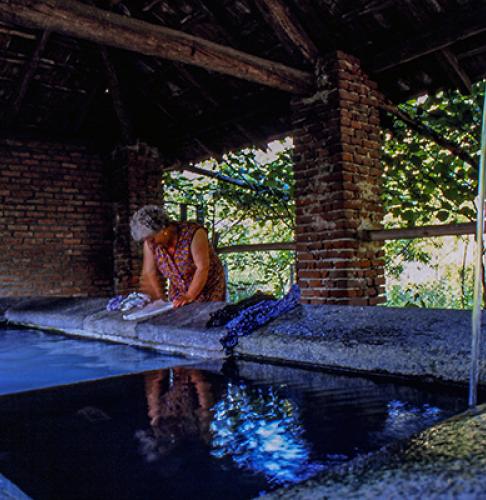Historical Background
The oldest evidence of human presence in the territory of Varese is in Angera and dates back to the Upper Palaeolithic. Important archaeological finds were made at the beginning of the 20th century in Tana del Lupo, a cave located on the southern slopes of La Rocca. Though there is archaeological evidence from the Neolithic period in several inland locations, no finds from the Bronze Age, the era of the culture of Golasecca, have yet been identified in Angera.
Discoveries from as far back as the 16th century and the archaeological research carried out since the end of the 19th century, have brought to light much evidence of the Roman period and these finds populate the museums of the whole region. Most significant were the excavations of the Roman necropolis, whose finds are exhibited in the Museum. Even today, considerable evidence emerges from the topsoil whenever there is any building or excavation done in the village and surrounding district.
The village has been inhabited since at least the 2nd century BC. In Roman times it was an important commercial centre and port of call on the river system that connected Verbano (Lake Maggiore), the rivers Ticino and Po and the Adriatic Sea, and the Mediolanum-Verbannus road that connected the ancient village now known as Angera to the city of Milan, which was then called Mediolanum.
We do not know the name of the village when it was a Roman vicus, but we know that in the early Middle Ages the village was called Statio or Stazzona and that the name Angleria did not appear before the twelfth century. In the early Middle Ages the first fortifications were built in the place where the fortress (La Rocca) now stands, and in the eleventh century Angera and its castle became part of the possessions of the diocese of Milan. In 1277 Ottone Visconti, Bishop of Milan, succeeded in defeating the noble family Torriani who controlled Milan, and the victory of Desio is memorialised in the famous Sala di Giustizia (Hall of Justice) in La Rocca of Angera. It was from here that the Visconti family started the journey that led them to take control of Milan. Gian Galeazzo Visconti, former Count of Angera, later obtained the title of Duke of Milan from Emperor Wenceslas and in 1397 Angera became the principal town of a vast area, which included almost all of Lake Maggiore.
When the Visconti family fell in 1449, the Golden Ambrosian Republic, threatened by the Venetian army near Milan, ceded the territory of Angera to the Borromeo family, in exchange for military assistance. At the head of this army was Francesco Sforza and with the advent of the Sforza family in Milan, the territory of Angera was not always in harmony with the Borromeo family. In 1497 Ludovico il Moro (the black) Sforza, elevated the village to city status, made it the seat of the Capitano di Lago Maggiore and granted citizens the right to a market and two annual fairs. Il Moro also gave the population significant exemptions from paying duties on the goods that circulated on Lake Maggiore, to the detriment of the Borromeo family, who would have benefitted from them. From 1535 Angera, as did all of the Duchy of Milan, passed under Spanish rule, and was again granted as a fief to the Borromeo, at least until 1577, when it returned to direct rule from the government of Milan. In 1623 Cardinal Federico Borromeo bought the fiefdom back, with the title of Marquis, for himself and his nephews. The Cardinal, who was able to rekindle a relationship of trust with the people of Angera, reconstituted the Collegiate Church in the church of S. Maria Assunta with a Chapter of six canons. The Cardinal also obtained freedom for fishing for the people of Angera: in 1623 King Philip of Aragon granted the civic use of fishing to the inhabitants of Angera and Ranco, which is still in force today. At the beginning of 1700, after almost two centuries of Spanish domination, the Duchy of Milan, and with it Angera, passed under Austrian rule which, except for a brief time during the Napoleonic period, lasted until the Unification of Italy. The Treaty of Worms of 1744 sanctioned the passage of the western shore to Piedmont. Angera thus became a border town and therefore one of the most important centres for the flourishing exchange of goods from all over Europe, through the Piedmontese kingdom and Switzerland. In 1819 the Austrian government built the still existing customs port, keeping alive a commercial vocation that had never failed.
After the war of 1859 and the liberation of Lombardy from Austrian domination, Angera became part of the Kingdom of Italy. The arrival of the railway between Sesto Calende and Domodossola in 1868 and the subsequent opening of the Semplon tunnel into Switzerland in 1906, led to the rapid decline of water transport. Goods were now transported entirely by rail.
Angera, for centuries an important commercial port, was thus in decay and the process that led to the complete economic and productive renewal of the territory and the emergence of new industries had to begin. Between the end of the nineteenth and early twentieth centuries some spinning mills were opened, which became important textile industries and were active until after the Second World War.
The presence of lime and crushed stone quarries in the territory favoured the beginning of a new industrial presence at the beginning of the twentieth century when the Società Generale per l’Industria della Magnesia (General Society of the Magnesia Industry), became a significant employer for a large number of workers in Angera until 2011.
On 24 April 1954, Angera was again proclaimed a city by the President of the Republic Luigi Einaudi and has since been officially recognized as a Tourist Resort.













